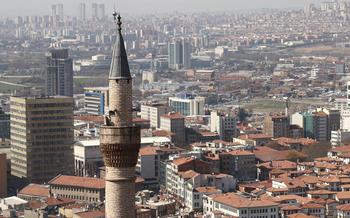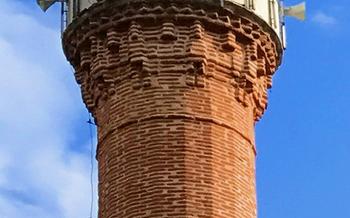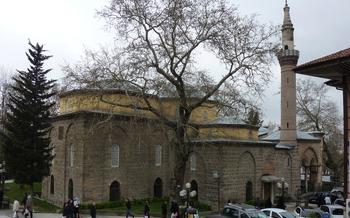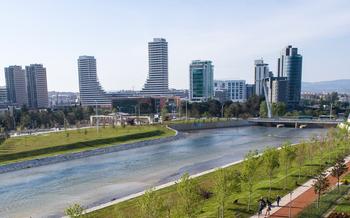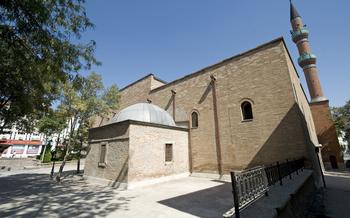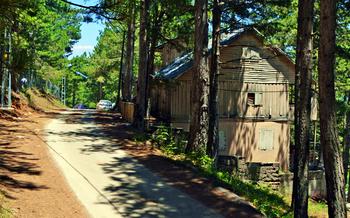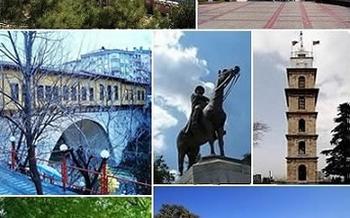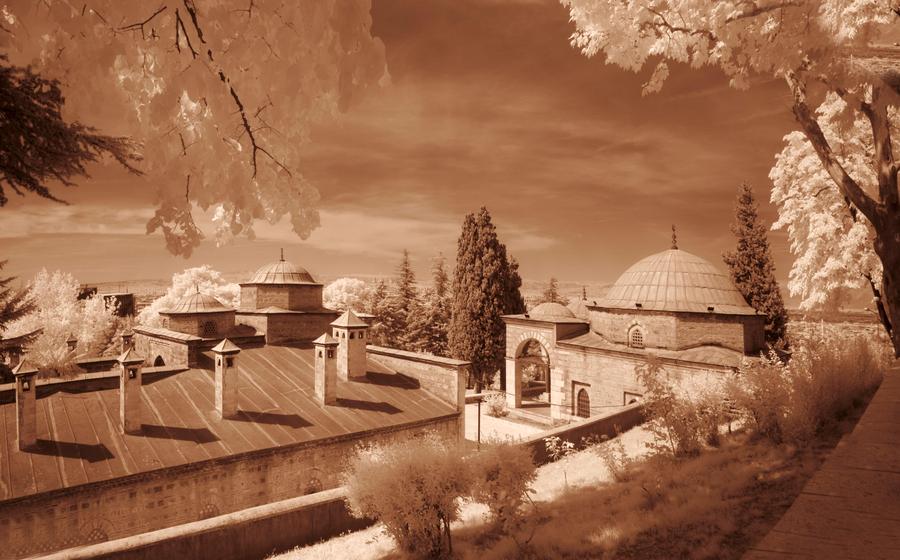
Yıldırım Bayezid Mosque
- The Yıldırım Bayezid Mosque: A Masterpiece of Ottoman Architecture
- Personal Anecdote
- Location and Accessibility:
- Exploring the Mosque's Interior
- The Mosque's Courtyard and Surroundings
- The Mosque's Religious Significance and Worship
- Historical Context and Background
- Architectural Details and Design:
- Cultural and Social Significance
- Photography and Videography
- Accessibility for Visitors with Disabilities
- Local Customs and Etiquette
- Combining the Mosque with Other Bursa Attractions
- Recommended Tours and Guides
The Yıldırım Bayezid Mosque: A Masterpiece of Ottoman Architecture
The Yıldırım Bayezid Mosque, a magnificent edifice that adorns the heart of Bursa, stands as a testament to the grandeur and artistry of Ottoman architecture. Commissioned by Sultan Yıldırım Bayezid I in the late 14th century, this iconic mosque has played a pivotal role in shaping the city's religious and cultural landscape.
With its soaring minarets piercing the skyline and its intricate tilework adorning its facade, the Yıldırım Bayezid Mosque exudes an aura of awe and reverence. Its spacious courtyard, adorned with a serene fountain, invites visitors to pause and reflect amidst the tranquility of this sacred space.
Beyond its architectural splendor, the Yıldırım Bayezid Mosque holds immense religious significance for the Muslim community. As one of the most important mosques in Bursa, it serves as a hub for daily prayers, congregational gatherings, and spiritual contemplation. The mosque's interior is adorned with exquisite Islamic calligraphy, intricate carvings, and stunning stained-glass windows, creating an atmosphere that fosters devotion and piety.
Personal Anecdote
During my visit to the Yıldırım Bayezid Mosque, I was struck by the palpable sense of spirituality that permeated the air. As I stepped inside the vast prayer hall, I couldn't help but feel a profound sense of peace and serenity wash over me. The rhythmic chanting of the Quran filled the space, creating a mesmerizing symphony that transported me to a realm of tranquility.
In that moment, I realized that the Yıldırım Bayezid Mosque was more than just a architectural masterpiece; it was a living testament to the enduring power of faith and the enduring legacy of Ottoman craftsmanship.
Location and Accessibility:
The Yıldırım Bayezid Mosque is strategically located in the heart of Bursa's historic district, within easy reach of the city's other landmarks and attractions. To get there, visitors can take a short walk from the nearby Ulu Cami or the bustling Grand Bazaar, immersing themselves in the vibrant atmosphere of Bursa's old town. Alternatively, public transportation options such as buses and taxis are readily available, making the mosque easily accessible from any part of the city.
Once you arrive, you'll find yourself in a tranquil oasis amidst the lively surroundings. The mosque's courtyard, surrounded by lush gardens and cascading fountains, offers a serene respite from the city's hustle and bustle. Take a moment to appreciate the intricate tilework and calligraphy adorning the mosque's exterior before stepping inside to explore its awe-inspiring interior.
Exploring the Mosque's Interior
Venturing inside the Yıldırım Bayezid Mosque is like stepping into a realm of exquisite artistry and intricate craftsmanship. The mosque's interior is a symphony of Islamic design elements, showcasing the grandeur and devotion that went into its creation.
The mihrab, the sacred niche indicating the direction of Mecca, is a masterpiece of tilework and calligraphy. Its intricate geometric patterns and verses from the Quran create a mesmerizing focal point for prayer and contemplation.
The minbar, the elevated pulpit from which sermons are delivered, is an equally impressive work of art. Carved from a single block of marble, it features intricate carvings and delicate inlay work, narrating stories from the life of the Prophet Muhammad and his companions.
The dome, towering above the prayer hall, is a testament to the mosque's architectural prowess. Its vast expanse is adorned with radiant calligraphy, verses from the Quran, and the names of Allah and the Prophet Muhammad, creating a celestial atmosphere that inspires awe and reverence.
The qibla wall facing Mecca, displays a stunning array of colorful Iznik tiles, each hand-painted with floral motifs and geometric patterns. The tiles seem to dance in the soft light filtering through the stained-glass windows, casting a warm and ethereal glow upon the entire space.
My personal impression of the mosque's interior was one of profound serenity and wonder. The intricate details and harmonious blend of colors created an atmosphere of peace and tranquility, inviting me to pause and reflect on the spiritual significance of this sacred space.
The Mosque's Courtyard and Surroundings
The courtyard of the Yıldırım Bayezid Mosque is a serene and inviting space, offering a tranquil respite from the bustling city. As you step into the courtyard, you'll be greeted by a beautifully manicured garden, featuring vibrant flowers, lush greenery, and towering trees. The courtyard is surrounded by elegant arcades, supported by slender columns and intricate arches. These arcades provide shade and shelter from the sun and rain, creating a pleasant ambiance for visitors to relax and contemplate.
In the center of the courtyard, you'll find a stunning ablution fountain, where worshippers can perform their ritual cleansing before entering the mosque for prayer. The fountain is adorned with intricate carvings and colorful tiles, showcasing the exquisite craftsmanship of the Ottoman artisans. The courtyard also features several benches, allowing visitors to sit and enjoy the peaceful surroundings, immersing themselves in the mosque's spiritual atmosphere.
The area surrounding the Yıldırım Bayezid Mosque is steeped in historical significance. Just a short walk away, you'll find the historic Grand Bazaar of Bursa, a vibrant marketplace where you can shop for traditional Turkish handicrafts, souvenirs, and delicacies. The bazaar is a bustling hub of activity, offering a glimpse into the city's rich cultural heritage.
The mosque is also surrounded by several other notable landmarks, including the Muradiye Mosque, the Koza Han, and the Bursa Archeological Museum. These sites offer a deeper insight into Bursa's fascinating history and cultural legacy, making the area a treasure trove for history enthusiasts and culture seekers.
The Mosque's Religious Significance and Worship
The Yıldırım Bayezid Mosque holds immense religious significance as a central place of worship for Muslims in Bursa. It serves as a community hub where the faithful gather for daily prayers, including the five mandatory daily prayers: Fajr (dawn), Dhuhr (noon), Asr (afternoon), Maghrib (sunset), and Isha (night). During these prayer times, the mosque's spacious interior resonates with the melodious recitation of the Quran and the collective voices of worshippers performing their prayers in unison.
Beyond daily prayers, the mosque also hosts special religious events and observances throughout the year. During the holy month of Ramadan, the mosque becomes a focal point for extended prayers, Quranic recitations, and communal iftars (fast-breaking meals). The mosque's courtyard and surroundings transform into a vibrant gathering space, where families and friends come together to share meals, socialize, and celebrate the spiritual essence of the month.
Visitors to the mosque are welcome to observe these religious rituals and practices, provided they are respectful of the sanctity of the space and observe appropriate etiquette. It is customary to dress modestly, maintain silence, and avoid causing any disruption during prayer times. By immersing themselves in the mosque's spiritual atmosphere, visitors can gain a deeper understanding of Islamic traditions and the importance of community in Muslim societies.
Historical Context and Background
The Yıldırım Bayezid Mosque holds a significant place in Ottoman history and architecture. Its construction was commissioned by Sultan Yıldırım Bayezid I, a prominent ruler who reigned during the late 14th and early 15th centuries. Bayezid's ambition was to create a magnificent edifice that would rival the architectural wonders of his predecessors and serve as a testament to his power and piety.
The mosque's construction began in 1399 and was completed in 1400, shortly before Bayezid's defeat at the Battle of Ankara. Despite this setback, the mosque stands as a lasting legacy of Bayezid's reign and the architectural achievements of the early Ottoman period.
Over the centuries, the mosque has undergone several renovations and additions, reflecting the changing tastes and needs of subsequent generations. These include the construction of a new minaret in the 16th century and the addition of a medrese (Islamic school) in the 18th century. These modifications have contributed to the mosque's rich architectural heritage and showcase the enduring significance of this sacred space.
Legends and stories have also woven themselves around the mosque, adding to its mystical allure. One tale speaks of a hidden treasure buried beneath the mosque's foundations, a testament to the wealth and power of the Ottoman sultans. Another legend tells of a secret tunnel connecting the mosque to the nearby Uludağ mountains, providing a means of escape in times of danger.
These historical narratives and legends offer a glimpse into the mosque's storied past and the enduring fascination it holds for visitors from all walks of life.
Architectural Details and Design:
The Yıldırım Bayezid Mosque stands as a testament to the architectural brilliance of the Ottoman era. Its design seamlessly blends Islamic and Anatolian elements, creating a harmonious aesthetic that captivates visitors. The mosque's striking features include its massive dome, intricate tilework, and graceful minarets. The dome, a symbol of Islamic architecture, dominates the skyline and is a testament to the mosque's grandeur. Its exterior is adorned with intricate geometric patterns and calligraphy, showcasing the artistry and precision of Ottoman craftsmanship. The minarets, slender and elegant, provide a sense of balance and symmetry to the mosque's overall design.
Inside the mosque, visitors are greeted by a spacious prayer hall supported by rows of elegant columns. The mihrab, or prayer niche, is a masterpiece of Islamic art, featuring intricate carvings and colorful tiles that draw the eye. The minbar, or pulpit, is adorned with delicate woodwork and inscriptions, adding to the mosque's rich ornamentation. The mosque's interior is illuminated by natural light that filters through the stained glass windows, creating a serene and contemplative atmosphere.
The Yıldırım Bayezid Mosque is not just a place of worship but also a symbol of Ottoman power and prestige. Its architectural details and design elements reflect the empire's commitment to artistic excellence and its mastery of Islamic architecture. Exploring the mosque's intricate features offers visitors a glimpse into the rich history and cultural heritage of Bursa and the Ottoman Empire.
Cultural and Social Significance
Beyond its religious significance, the Yıldırım Bayezid Mosque holds a prominent place in the cultural and social fabric of Bursa. It serves as a community hub, hosting various events and gatherings throughout the year. These events range from religious celebrations to cultural exhibitions, fostering a sense of unity and belonging among the local population.
The mosque's courtyard transforms into a vibrant gathering space, where locals come together for festivals, ceremonies, and community meetings. These events provide opportunities for people to connect, share traditions, and celebrate their shared heritage. The mosque's architecture and serene ambiance create a welcoming environment that encourages social interaction and cultural exchange.
Furthermore, the Yıldırım Bayezid Mosque has significantly contributed to Bursa's cultural heritage. Its unique architectural style, intricate tilework, and historical significance have made it a symbol of the city's rich past. The mosque is a source of pride for the people of Bursa and is often featured in local art, literature, and folklore.
During my visit, I had the privilege of witnessing firsthand the mosque's role in the community. I attended a traditional Turkish coffee ceremony held in the courtyard, where locals gathered to socialize, share stories, and enjoy each other's company. The warm hospitality and sense of camaraderie I experienced left a lasting impression on me, showcasing the mosque's profound impact on the cultural and social life of Bursa.
Photography and Videography
When visiting the Yıldırım Bayezid Mosque, visitors are welcome to capture the beauty of its architecture and intricate details through photography and videography. However, it is essential to respect the sanctity of the religious space and adhere to the following guidelines:
-
Respectful Capturing: Photography and videography should be conducted in a respectful manner, ensuring that worshippers are not disturbed or distracted during their prayers.
-
Appropriate Attire: Visitors should dress modestly and appropriately, adhering to the local customs and dress code when taking photos or videos inside the mosque.
-
No Flash: The use of flash photography is generally discouraged, as it can be disruptive and disrespectful during prayer times.
-
Designated Areas: Some areas of the mosque may be designated for photography and videography, while others may be restricted. Visitors should follow the instructions provided by the mosque authorities or tour guides.
-
Social Media Sharing: Sharing photos and videos on social media platforms is permitted, but it is important to ensure that the content is respectful and does not violate the privacy of other visitors or the sanctity of the mosque.
Accessibility for Visitors with Disabilities
The Yıldırım Bayezid Mosque recognizes the importance of accessibility for visitors with disabilities. To ensure an inclusive and welcoming environment, the mosque has implemented several accessibility features. Wheelchair users and visitors with limited mobility can easily access the mosque's courtyard and interior through designated ramps and elevators. These ramps and elevators are strategically placed to provide a smooth and convenient experience for all visitors. Inside the mosque, there are designated areas for assisted prayer or observation, allowing individuals with disabilities to fully participate in religious activities. While the mosque has made significant efforts to enhance accessibility, it's essential to note that certain areas may still present challenges due to the historical nature of the building. Visitors with specific accessibility needs are encouraged to contact the mosque's administration in advance to ensure a tailored and enjoyable experience.
Local Customs and Etiquette
When visiting the Yıldırım Bayezid Mosque, it is important to be respectful of local customs and traditions. Modest dress is expected, with visitors covering their shoulders and knees. Women may also choose to cover their hair, although this is not mandatory. Upon entering the mosque, visitors should remove their shoes and place them in the designated racks. It is considered disrespectful to wear shoes inside the prayer hall.
When inside the mosque, visitors should be mindful of their behavior. Loud talking and laughter are not appropriate, and it is important to maintain a respectful silence. Visitors should also avoid walking in front of people who are praying. If you wish to take photos, be sure to ask permission first and avoid using flash photography.
Interacting with locals in a respectful manner is also important. A friendly smile and greeting go a long way, and visitors should be open to learning about local customs and traditions. By showing respect and understanding, visitors can help to create a positive and welcoming atmosphere at the Yıldırım Bayezid Mosque.
Combining the Mosque with Other Bursa Attractions
To make the most of your time in Bursa, consider combining your visit to Yıldırım Bayezid Mosque with other nearby attractions. Begin your day by exploring this magnificent mosque, immersing yourself in its history, architecture, and spiritual significance. Afterwards, stroll through the vibrant streets of Bursa, discovering hidden gems and local treasures.
For breathtaking natural beauty, take a cable car up to Uludağ, a nearby mountain renowned for its scenic views and ski resorts. Indulge in winter sports during the snowy season, or simply admire the panoramic vistas from one of the many cafes and restaurants.
If you are interested in history and culture, visit the Grand Bazaar, a bustling marketplace where you can find everything from traditional Turkish handicrafts to local delicacies. Experience the vibrant atmosphere, haggle with friendly vendors, and take home unique souvenirs to cherish.
To delve deeper into Bursa's rich past, explore its many museums. The Bursa Museum of Archaeology houses artifacts from the city's ancient past, while the Bursa City Museum showcases its more recent history and development. Learn about the city's role as the first capital of the Ottoman Empire and discover the stories of its diverse inhabitants.
Plan your itinerary carefully to make the most of your time in Bursa. Allocate sufficient time for each attraction, considering travel distances and operating hours. Prioritize your interests and choose activities that align with your preferences. Whether you seek natural wonders, historical insights, or cultural experiences, Bursa has something to offer every traveler.
Recommended Tours and Guides
For a more immersive experience, consider joining a guided tour of the Yıldırım Bayezid Mosque. Guided tours are available in various languages, including English, Arabic, and Turkish. Knowledgeable guides will provide insights into the mosque's history, architecture, and religious significance. They can also share stories and anecdotes about the mosque and its role in the local community.
I highly recommend booking a tour with a reputable tour operator or guide. Look for companies that specialize in cultural and historical tours of Bursa. Read reviews and recommendations online to find a guide who is knowledgeable, friendly, and passionate about sharing their city's heritage.
Guided tours typically last for about an hour and cover the mosque's interior, courtyard, and surrounding area. They can be customized to fit your interests and time constraints. Whether you're a history buff, an architecture enthusiast, or simply someone who wants to learn more about Turkish culture, a guided tour is an excellent way to enhance your visit to the Yıldırım Bayezid Mosque.

